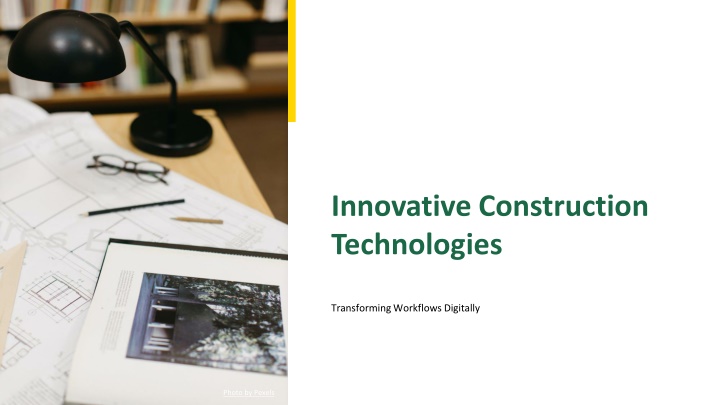
Innovative Construction Technologies Revolutionizing Workflows
"Explore innovative construction technologies reshaping traditional workflows, enhancing efficiency, and transforming the construction landscape. Discover how laser scanning, Scan to BIM, progress tracking, and 360-degree photography are leading to remarkable outcomes in the industry."
Download Presentation

Please find below an Image/Link to download the presentation.
The content on the website is provided AS IS for your information and personal use only. It may not be sold, licensed, or shared on other websites without obtaining consent from the author. If you encounter any issues during the download, it is possible that the publisher has removed the file from their server.
You are allowed to download the files provided on this website for personal or commercial use, subject to the condition that they are used lawfully. All files are the property of their respective owners.
The content on the website is provided AS IS for your information and personal use only. It may not be sold, licensed, or shared on other websites without obtaining consent from the author.
E N D
Presentation Transcript
Innovative Construction Technologies Transforming Workflows Digitally Photo by Pexels
01 Revolutionizing Construction Table of Contents 02 Understanding Scan to BIM 03 Laser Scanning Defined 04 Tracking Construction Progress 05 360 Degree Photography 06 Streamlined Workflows 07 Case Studies Overview 08 Benefits to Stakeholders 09 Future of Construction 10 Conclusion
1 Revolutionizing Construction A New Age The construction industry is evolving rapidly with innovative technologies that reshape traditional workflows and enhance efficiency. Technologies like laser scanning provide precise data, facilitating improved project planning and execution for construction teams worldwide. Embracing these changes is vital for businesses aiming to stay competitive in a fast-paced environment. This presentation explores how these advancements can transform the construction landscape, leading to remarkable outcomes. Photo by Pexels
2 Understanding Scan to BIM Technology in Focus Scan to BIM (Building Information Modeling) integrates laser- scanned data into 3D models, enhancing accuracy and facilitating collaboration. This method reduces errors and streamlines processes, ensuring that all stakeholders work with the most up-to-date information. Using this technology, architects can visualize construction elements in detail before actual building takes place. It's a crucial step towards smarter constructions in a digital- first environment, provingits worth across various projects. Photo by Pexels
3 Laser Scanning Defined Precision Matters Laser scanning captures millions of data points to create highly accurate 3D models, providing unprecedented precision in construction projects. This technology allows for the detailed documentation of existing structures, helping in renovation and retrofitting processes. It also aids in identifying issues early on, reducing costly rework and delays duringconstruction. Ultimately, laser scanning fosters a collaborative approach where architects and engineers can work together seamlessly. Photo by Pexels
4 Tracking Construction Progress Stay on Schedule Modern technologies offer innovative methods for tracking on-site progress, ensuring projects remain on schedule and within budget. Using mobile applications and digital platforms, teams can monitor real-time developments and adjust plans accordingly. This proactive approach minimizes delays and improves accountability among team members throughout the construction process. Ultimately, tracking progress efficiently translates to better outcomes and client satisfaction. Photo by Pexels
5 360 Degree Photography A New Perspective 360-degree photography allows for immersive monitoring of progress, capturing the entirety of the construction site in detail. This technology provides stakeholders with a comprehensive view, facilitating informed decision-making and timely interventions. Project managers can quickly share updates with clients, fostering transparency and trust in the project's development. It's an innovative solution that enhances communication and keeps everyone on the same page. Photo by Pexels
6 Streamlined Workflows Efficiency Redefined Integrating advanced technologies like laser scanning and photography creates streamlined workflows that enhance productivity in construction. Automation and real-time data access reduce manual labor, allowing teams to focus on more critical tasks. This shift in processes is fundamental to modern construction practices, promoting agile methodologies and quick adaptations. As technology advances, the construction industry will witness even more profound transformations in how work is executed. Photo by Pexels
7 Case Studies Overview Real Life Applications Examining case studies reveals the practical benefits of implementing innovative construction technologies in various projects. For example, a recent project utilizing laser scanning reduced project costs significantly by eliminating rework. Other case studies highlight improvements in safety and compliance throughbetter planning and risk assessment. These real-life applications illustrate the transformative power of technology in enhancing construction outcomes. Photo by Pexels
8 Benefits to Stakeholders Why It Matters Stakeholders - from contractors to clients - experience significant advantages when adopting these technologies, including cost savings and quicker timelines. Improved accuracy leads to fewer disputes and miscommunications, fostering better relationships among all parties involved. Moreover, these technologies ensure a safer working environment by identifying potential hazards before construction starts. Ultimately, the benefits extend beyond immediate metrics, shaping a more sustainable future for the construction Photo by Pexels industry.
9 Future of Construction Looking Ahead The future of construction will rely heavily on continued technological advancements and the integration of smart solutions. As digital tools become more sophisticated, they will foster collaboration and efficiency, driving the industryforward. Emerging technologies such as AI and machine learning will complement existing methods, enabling new possibilities. This evolution will redefine construction standards, paving the way for innovative practices that prioritize sustainability and efficiency. Photo by Pexels
10 Conclusion Wrapping Up In conclusion, adopting innovative construction technologies is essential to staying relevant and competitive in today's market. The case studies and technologies discussed highlight the benefits of embracing change and modernizing workflows. As the industry moves forward, collaboration and integration will remain key to success in construction. Thank you for your attention and interest in transforming the construction landscape throughtechnology. Photo by Pexels
